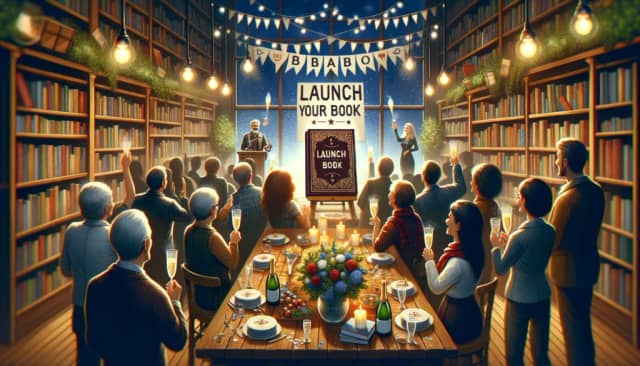Table of Contents
So, you’ve got this amazing book idea brewing, right? Well, the first big leap into the world of publishing is making sure your manuscript is the best it can be. Think of it like baking your favorite cake for a friend’s birthday—you want it to taste heavenly and leave them wanting more.
Step 1: Perfect Your Manuscript

There are a few things your should have in mind, here it goes:
Focus on Rewriting
Rewriting is where the magic happens. Your first draft is just you telling yourself the story, but the subsequent drafts? That’s where you refine it into something your readers can’t put down. Don’t rush this part. Take your time to enhance your plot, flesh out characters, and tighten up your prose.
Seek Feedback
Getting feedback is like having a friend taste-test your cake—they’ll tell you if it needs more sugar or if the chocolate flavor really pops. For your manuscript, beta readers are these taste-testers. But where do you find them? Goodreads and writing forums like Absolute Write Water Cooler are great places to start. Join communities related to your genre, and you’ll find people willing to swap manuscripts for feedback. It’s like a book club, but with drafts.
Hire a Professional Editor
Now, let’s talk about getting a professional editor. This step is like hiring a gourmet chef to teach you the finer points of making that cake even more delicious. Yes, it costs, but the investment can dramatically improve your manuscript. Websites like Reedsy and the Editorial Freelancers Association are fantastic places to find reputable editors. Look for someone with experience in your genre. They’ll offer insights and suggestions that you might never have considered on your own.
Editors usually offer different levels of service:
- Developmental editing helps shape the structure and content.
- Copyediting focuses on grammar, syntax, and word choice.
- Proofreading is your final check for typos and formatting errors.
Choose what fits your needs and budget. Remember, a good editor doesn’t rewrite your story for you; they help you bring out its best version.
Embrace the Process
Perfecting your manuscript is a journey. There will be moments of frustration, but also moments of pure joy when everything clicks into place. Celebrate those small victories—a chapter that sings, a character that feels alive, dialogue that crackles with energy.
And hey, don’t forget to step back once in a while and enjoy the process. Writing a book is a massive achievement, and getting to the point where you’re ready to share it with the world is something to be proud of. So, keep at it, and remember, every great book went through countless drafts before it hit the shelves. Yours will be no different. Let’s make it a masterpiece together.
Write it with AI in the first place
Currently, AI is blooming and there are tools that write entire books from scratch. As language powered models, these software are almost impeccable when it comes to grammar and style of writing (it does exactly what you prompt it to do).
So, feel free to try out AI eBook Creator and see it for yourself.
Step 2: Your Publishing Options

Alright, let’s dive into the next big thing on our publishing adventure: figuring out the best route to get your book out into the world. It’s a bit like deciding whether to bake that cake at home or have it made at a fancy bakery. Both options can lead to a delicious outcome, but the experiences will be quite different.
Traditional vs. Self-Publishing
First up, traditional publishing. Imagine handing over your cake recipe to a top-notch bakery. They’ll handle everything—ingredients, baking, decoration, and even getting it into the best cake shops. In the book world, this means a publishing house takes care of editing, design, distribution, and some marketing. The catch? Getting into these bakeries (publishers) is tough. You’ll need a query letter, possibly an agent, and the patience to deal with rejection and long waits.
Now, self-publishing. This is you, in your kitchen, baking and decorating the cake exactly how you like it. You have control over every aspect of the process, from writing and editing to cover design and where to sell it. Platforms like Amazon KDP, Smashwords, and Draft2Digital have made it easier than ever to get your book out there. The challenge here is that all the responsibilities fall on you, including marketing and getting reviews, which can be both freeing and daunting.
Consider Hybrid Publishing
Then there’s the middle ground: hybrid publishing. It’s like baking your cake at home but hiring a local cake shop to help with the tricky parts, like icing decorations. Hybrid publishers offer services to help you publish your book, often for a fee. They may offer more support than going it alone, but you’ll still have more control over the process than with traditional publishing. Just be cautious and do your research to avoid vanity presses that offer little value for a high cost.
Making Your Choice
How do you decide? Think about what matters most to you. Do you crave the validation and support that comes with traditional publishing? Or do you value creative control and the potential for higher royalties per book with self-publishing?
Tips for Making the Decision
- Research: Look into success stories for both routes in your genre. What seems to align more with your goals and temperament?
- Network: Chat with other authors. Facebook groups, Twitter, and author forums can be goldmines of information and support.
- Consider Your Skills: Are you up for learning about marketing, cover design, and sales channels? Or would you prefer to focus just on writing and leave the rest to a publisher?
- Long-Term Goals: Think about where you see your writing career going. Do you want to publish many books quickly, or are you aiming for the prestige of traditional publishing?
Step 3: Prepare Your Submission Materials

Grab your coffee, because now we’re getting into the nitty-gritty of making your dream a reality. Preparing your submission materials is like putting together a portfolio of your best work to show off. Whether you’re wooing a traditional publisher or going the self-publishing route, you need to put your best foot forward.
For Traditional Publishing
Craft a Compelling Query Letter
Think of your query letter as the cover letter for your manuscript. It’s your first impression, so make it count. Here’s a quick recipe:
- Hook: Start with an enticing summary of your book that grabs attention.
- Book Summary: Give a brief overview of your story or non-fiction book’s premise, focusing on what makes it unique.
- Author Bio: Share a bit about yourself, highlighting any writing credentials, awards, or relevant experiences.
- Tailor It: Customize your letter for each agent or publisher you’re contacting. Show that you’ve done your homework about why your book would be a good fit for them.
Websites like QueryTracker can help you find agents, and Writer’s Digest offers tons of advice on crafting a winning query.
Write a Synopsis
This is a detailed summary of your book, laying out the plot and revealing even the ending. It’s your chance to show the structure and flow of your story. Keep it concise, typically no more than 1-2 pages.
Prepare Your Author Bio
Even if you haven’t published before, you’ve got a story. Highlight your passion for writing, any relevant life experiences, and why you’re the person to tell this story.
For Self-Publishing
Design a Captivating Cover
Your cover is your billboard. It needs to scream “pick me!” in a sea of books. If design isn’t your forte, consider hiring a professional. Websites like 99Designs or Fiverr offer access to freelance designers with book cover expertise. Remember, your cover should reflect the genre and tone of your book.
Format Your Manuscript
Formatting for eBooks and print can be tricky, but tools like Scrivener, Vellum (Mac only), or the Reedsy Book Editor can help simplify the process. Make sure to follow the guidelines of the platform you’re publishing on, like Amazon KDP or Barnes & Noble Press.
Technical Requirements
Don’t forget about getting an ISBN (International Standard Book Number). It’s like your book’s fingerprint. In many countries, you can purchase them through your national ISBN agency. For eBooks, some platforms offer a free ISBN, but purchasing your own gives you more control.
Step 4: Find the Right Publisher or Platform

For Traditional Publishing
Research Agents and Publishers
It’s time to find your publishing soulmate. Use directories like the Writers’ Market or the aforementioned QueryTracker to research agents and publishers that specialize in your genre. Attend writer’s conferences or online webinars to network and learn more about specific agents and publishers’ preferences.
Understand Submission Guidelines
Each agent and publisher has their own set of rules for submissions. Some might want just the query letter and the first few pages of your manuscript, while others might request a query, synopsis, and the first three chapters. Follow these to the letter to increase your chances of being taken seriously.
Handle Rejection Gracefully
Rejection is part of the game. J.K. Rowling was turned down multiple times before “Harry Potter” found a home. Use rejection as a learning opportunity. If you get feedback, cherish it and use it to improve your next submission.
For Self-Publishing
Choose a Publishing Platform
Research and compare platforms like Amazon KDP, Apple Books for Authors, Kobo Writing Life, and others. Consider factors like royalty rates, distribution channels, and whether they offer print-on-demand services.
Distribution Channels
Think about where you want your book to be available. Exclusive programs like Amazon’s KDP Select offer perks but require you to sell your eBook only through Amazon. Weigh the pros and cons based on your goals.
Step 5: Market and Promote Your Book

This is where you put on your marketer hat. No matter how great your book is, it won’t sell itself. Start building an author platform—your website, social media presence, and email list—well before your book launches. Consider creating a launch plan that includes a book cover reveal, seeking advance reviews, and setting up a pre-order. Social media ads, book bloggers, and email marketing can also be powerful tools in your arsenal.
Remember, the journey of publishing your first book is a marathon, not a sprint. It’s filled with learning opportunities, and each step you take brings you closer to your goal. Keep your spirits high, stay committed, and let your passion for storytelling drive you forward. You’ve got this!
Step 6: Launch Your Book

This is it—the big day! Launching your book can feel as exhilarating as hosting a grand party where everyone’s toasting to your success. It’s your moment in the spotlight, so let’s make sure it shines bright.
Plan Your Book Launch
A successful launch starts with a solid plan. Think of it as planning a surprise party; you want everything to go off without a hitch.
- Set a Date: Choose a launch date that gives you enough time for promotion. Avoid major holidays when people might be too busy to notice.
- Create Buzz: Start teasing your book on your social media platforms, website, and newsletter. Share snippets, behind-the-scenes content, or the story of your writing journey.
- Organize a Virtual Event: Consider a live reading, Q&A session, or a virtual launch party on platforms like Zoom or Instagram Live. Invite friends, family, and followers to celebrate with you.
- Reach Out to Book Bloggers: Send advance copies of your book to bloggers and reviewers in your genre. Their reviews can drive early interest and sales.
Engage With Your Audience
Engagement is key to keeping the momentum going beyond launch day.
- Be Active on Social Media: Share updates, interesting tidbits about your book’s themes, or how readers’ perceptions are aligning with your intentions. Encourage discussions and feedback.
- Email Your List: If you’ve built an email list, send out a heartfelt thank you to everyone who supported you, with links to where they can buy the book or leave a review.
- Offer Promotions: A limited-time discount or bundle offer can encourage quick sales and reviews, helping your book gain visibility.
Collect and Leverage Reviews
Reviews are gold for authors. They provide social proof and influence potential readers.
- Encourage Reviews: Gently remind your readers to leave reviews on Amazon, Goodreads, and other platforms. Even a short review can make a big difference.
- Use Reviews in Marketing: Highlight positive reviews in your marketing materials, on your website, and in social media posts.
Step 7: Post-Publication Considerations

After the initial excitement of the launch settles, it’s easy to wonder, “What now?” Well, the journey doesn’t end here. It’s just beginning.
Navigate Post-Publication
The post-launch phase is crucial for keeping the momentum going and building your career as an author.
- Analyze the Outcome: Look at your sales figures, reviews, and reader feedback. What worked well? What could be improved for next time?
- Stay Engaged With Your Readers: Continue to be active on social media and your email list. Share your experiences, upcoming projects, and insights from your writing journey.
- Attend Literary Events: Whether virtual or in-person, participating in literary festivals, book fairs, and writing workshops can help you network and build your audience.
Plan for Your Next Book
Yes, it’s time to think about the next project. Here’s why starting on your next book can be the best step forward:
- Keep the Momentum Going: Your readers are excited now; capitalize on that enthusiasm by offering teasers of your next work.
- Apply What You’ve Learned: Use the insights and experiences from your first publication to streamline the process for your next book.
Keep Learning and Growing
The publishing industry is always evolving, and there’s always something new to learn. Stay curious, keep improving your craft, and never stop reading and writing.
Wrapping Up
Publishing your first book is a monumental achievement that sets the foundation for your writing career. Remember, every successful author was once where you are now. It takes persistence, patience, and passion to see your dreams turn into reality. So, take a moment to celebrate how far you’ve come, then roll up your sleeves and get ready for the next adventure. The world is waiting for more stories only you can tell.
Can you get a book published with no experience?
Absolutely! Many first-time authors publish their books each year, bringing fresh voices and new perspectives to readers worldwide. The key is focusing on crafting a compelling, well-edited manuscript and understanding the publishing industry’s basics. Whether you choose traditional publishing or self-publishing, there are resources and communities to support you on your journey. For traditional publishing, a strong query letter and persistence in finding the right agent or publisher can lead to success. In self-publishing, leveraging platforms like Amazon KDP or IngramSpark allows you to publish without prior experience. Remember, every experienced author was once a beginner.
How much do first-time authors make on a book?
Earnings for first-time authors can vary widely based on factors like publishing route, genre, marketing efforts, and the book’s reception. Traditionally published authors might receive an advance ranging from a few thousand dollars to higher amounts for those with high commercial potential, but they’ll earn royalties only after the advance “earns out.” Self-published authors could earn more per book because they receive a higher percentage of sales but without an advance. However, the average income for first-time authors is often under $10,000 a year, with many earning less, especially without strong marketing and sales strategies.
Are books still profitable?
Yes, books can still be profitable, but the level of profitability depends on various factors, including the publishing route, marketing efforts, niche or genre, and the author’s platform. Traditional publishers offer advances and royalties, sharing the financial risk with the author. Self-publishing gives authors higher royalties per book, but they shoulder the upfront costs of editing, design, and marketing. Niche markets and eBooks often offer lucrative opportunities for authors to earn. While not every book becomes a bestseller, strategic marketing, a loyal reader base, and leveraging multiple revenue streams (e.g., series, speaking engagements, merchandise) can significantly increase profitability.



